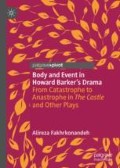Abstract
The primary aim here is to explore how “the evental” model informs Barker’s epistemological-aesthetic stance towards history. We will see how Barker’s drama, in its treatment and conception of history, diverges from various modes/trends of historical representation by developing an “evental”—rather than a linear-progressive or dialectical-teleological—model. This evental model is driven by the aporetic logic of arrivant (Anti-History) and actualization of the immanent virtual. Second, this chapter demonstrates the uncanny contemporaneity of The Castle and, more generally, Barker’s oeuvre particularly in the post-Brexit context where a binary/dichotomy-based discourse of nationalist ideology and national sovereignty (described here as “wall or encastling ideology”) has emerged not only in the UK but, more broadly, across the globe. Finally, this chapter intends to re-cast the established reading of The Castle—where Skinner is depicted as the main tragic protagonist—and posits Ann as the central character. Ann is here argued to embody an alternative (to the matriarchal or patriarchal) economy and ethics (of desire, gender, and subjectivity) thereby instigating the three pivotal events of the play: the re-writing of the Bible, the construction of the castle, and Krak’s symbolic conversion.
Access this chapter
Tax calculation will be finalised at checkout
Purchases are for personal use only
Notes
- 1.
Meaning an identity crisis on personal and national/collective levels, manifested particularly in the site of the boundary/border.
- 2.
See Julia Kristeva, Strangers to Ourselves 1–30, 96–102, 184–92; also see Homi K. Bhabha, “The Other Question,” in The Location of Culture (London: Routledge, 1994), 70–1.
- 3.
See Alireza Fakhrkonandeh, “Encastling England: Walls, Wallpapers, and Neo-Medievalism in Europe and Beyond,” delivered at Stronghold: Castles and the Culture of Nation Building Conference, Southampton University and Southampton City Art Gallery, 29 June 2017.
- 4.
- 5.
See also Holford et al. (2008). Viewing Boundary “Objects” as Boundary Constructions. In Proceedings of the 41st Hawaii International Conference on System Sciences, 1–11.
- 6.
Since its debut in 1985, there have been numerous reproductions of The Castle worldwide. Here I just refer to some of the most prominent ones (as noted by reviewers). (1) The Wrestling School Production, Riverside Studios, London in 1995. (2) The RSC in 2009, as part of 21 for 21 Anniversary. (3) Atlantic Stage 2, Off Broadway, August 4, 2013 directed by Cheryl Faraone; and (4) The Space Productions Company, London directed by Adam Hemming, October, 2017.
- 7.
See Jill Liddington, The Road to Greenham Common: Feminism and Anti-militarism in Britain Since 1820 (Syracuse University Press, 1989), 264–86; see also Lamb 94.
- 8.
See Barker’s interview with Dunn in Gambit 33–4.
- 9.
See Arguments 73.
- 10.
For details on this, see Edward Bond, “Commentary on the War Plays,” in The War Plays (London: Methuen, 1991), 315, 340, 247. Also see Edward Bond’s Letters, Volume 5, 184–5.
- 11.
For a detailed account of the role of narcissism in Baudrillard’s idea of seduction see Seduction 68.
- 12.
See also Lamb 7.
- 13.
See Douglas Kellner, Jean Baudrillard. Also William Pawlett, Jean Baudrillard: Against Banality (London: Routledge, 2007). See also Victoria Grace, Baudrillard’s Challenge (London: Routledge), 142–71.
- 14.
In the sense attributed to it by Levinas: the totality of ontology as opposed to the infinity of the Other singular individual (or alterity).
- 15.
See Alireza Fakhrkonandeh (2013).
- 16.
The term is Merleau-Ponty’s and designates a mode of relationality or being which is reducible neither to a dialectical synthesis nor to a binary opposition or antithesis. Conversely, hyper-dialectics involves a mode of relationship in which the otherness and singularity of both parties/phenomena involved is retained and not sublated (see VI 94).
- 17.
The key role of the cunt in The Castle is reflected in Krak’s obsession with its morphological and geometrical complexity in the wake of his intimacy with Ann, and in the castle’s approximation to it in terms of form (configuration) and function.
- 18.
See Luce Irigaray’s “Women’s Exile,” in Ideology and Consciousness, vol. 1 (1977).
Bibliography
Donesky, F. “Oppression, Resistance and the Writer’s Testament”—Interview with Howard Barker. New Theatre Quarterly II, no. 8 (November 1986): 336–44.
Fakhrkonandeh, Alireza. “Asyntactic Contact with Fleshless Words: Howard Barker’s The Castle.” Journal of Contemporary Drama in English 1, no. 2 (2013): 279–297.
Holford, W. D., M. Ebrahimi, O. Aktout and L. Simon. “Viewing Boundary ‘Objects’ as Boundary Constructions.” In Proceedings of the 41st Hawaii International Conference on System Sciences, 1–11, 2008.
Irigaray, Luce. “Women’s Exile.” Ideology and Consciousness 1. Elemental Passions. Trans. Joanne Collie and Judith Still. New York: Athlone Press, 1992.
Latour, B. “Visualization and Cognition: Thinking with Eyes and Hands.” Knowledge and Society: Studies in the Sociology of Culture Past and Present 6 (1986): 1–40.
———. Science in Action: How to Follow Scientists and Engineers through Society. Cambridge, MA: Harvard University Press, 1987.
Rabey, D. I. Howard Barker—Politics and Desire. London: Macmillan, 1989.
Star, S. L. and Griesemer, J. R. “Institutional Ecology, “Translations” and Boundary Objects: Amateurs and Professionals in Berkeley’s Museum of Vertebrate Zoology, 1907–1939.” Social Studies of Science 19 (1989): 387–420.
Author information
Authors and Affiliations
Corresponding author
Rights and permissions
Copyright information
© 2019 The Author(s)
About this chapter
Cite this chapter
Fakhrkonandeh, A. (2019). Encastleing England: Evental History and Histor(y)iography in Barker’s Work. In: Body and Event in Howard Barker's Drama. Palgrave Pivot, Cham. https://doi.org/10.1007/978-3-030-28699-6_1
Download citation
DOI: https://doi.org/10.1007/978-3-030-28699-6_1
Published:
Publisher Name: Palgrave Pivot, Cham
Print ISBN: 978-3-030-28698-9
Online ISBN: 978-3-030-28699-6
eBook Packages: Literature, Cultural and Media StudiesLiterature, Cultural and Media Studies (R0)

